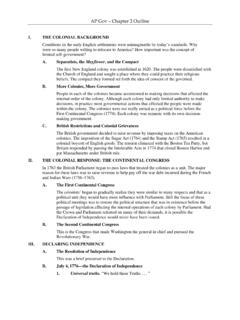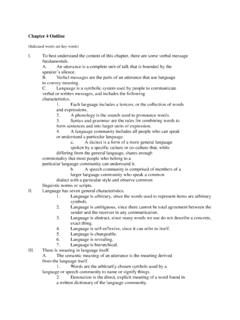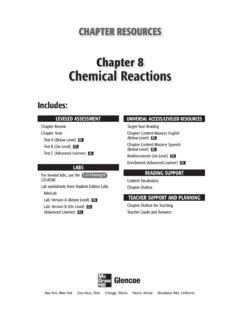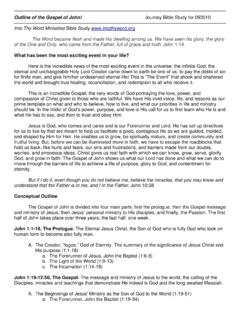Transcription of Chapter Outline - Rancho Santiago Community College District
1 Chapter 29 | Vertebrates 791. 29 | VERTEBRATES. Figure Examples of critically endangered vertebrate species include (a) the Siberian tiger (Panthera tigris), (b). the mountain gorilla (Gorilla beringei), and (c) the Philippine eagle (Pithecophega jefferyi). (credit a: modification of work by Dave Pape; credit b: modification of work by Dave Proffer; credit c: modification of work by "cuatrok77"/Flickr). Chapter Outline : Chordates : Fishes : Amphibians : Reptiles : Birds : Mammals : The Evolution of Primates Introduction Vertebrates are among the most recognizable organisms of the animal kingdom. More than 62,000 vertebrate species have been identified. The vertebrate species now living represent only a small portion of the vertebrates that have existed.
2 The best-known extinct vertebrates are the dinosaurs, a unique group of reptiles, which reached sizes not seen before or after in terrestrial animals. They were the dominant terrestrial animals for 150 million years, until they died out in a mass extinction near the end of the Cretaceous period. Although it is not known with certainty what caused their extinction, a great deal is known about the anatomy of the dinosaurs, given the preservation of skeletal elements in the fossil record. Currently, a number of vertebrate species face extinction primarily due to habitat loss and pollution. According to the International Union for the Conservation of Nature, more than 6,000 vertebrate species are classified as threatened. Amphibians and mammals are the classes with the greatest percentage of threatened species, with 29 percent of all amphibians and 21 percent of all mammals classified as threatened.
3 Attempts are being made around the world to prevent the extinction of threatened species. For example, the Biodiversity Action Plan is an international program, ratified by 188. countries, which is designed to protect species and habitats. | Chordates By the end of this section, you will be able to: Describe the distinguishing characteristics of chordates Identify the derived character of craniates that sets them apart from other chordates Describe the developmental fate of the notochord in vertebrates 792 Chapter 29 | Vertebrates Vertebrates are members of the kingdom Animalia and the phylum Chordata (Figure ). Recall that animals that possess bilateral symmetry can be divided into two groups protostomes and deuterostomes based on their patterns of embryonic development.
4 The deuterostomes, whose name translates as second mouth, consist of two phyla: Chordata and Echinodermata. Echinoderms are invertebrate marine animals that have pentaradial symmetry and a spiny body covering, a group that includes sea stars, sea urchins, and sea cucumbers. The most conspicuous and familiar members of Chordata are vertebrates, but this phylum also includes two groups of invertebrate chordates. Figure All chordates are deuterostomes possessing a notochord. Characteristics of Chordata Animals in the phylum Chordata share four key features that appear at some stage during their development: a notochord, a dorsal hollow nerve cord, pharyngeal slits, and a post-anal tail (Figure ). In some groups, some of these are present only during embryonic development.
5 The chordates are named for the notochord, which is a flexible, rod-shaped structure that is found in the embryonic stage of all chordates and in the adult stage of some chordate species. It is located between the digestive tube and the nerve cord, and provides skeletal support through the length of the body. In some chordates, the notochord acts as the primary axial support of the body throughout the animal's lifetime. In vertebrates, the notochord is present during embryonic development, at which time it induces the development of the neural tube and serves as a support for the developing embryonic body. The notochord, however, is not found in the postnatal stage of vertebrates; at this point, it has been replaced by the vertebral column (that is, the spine).
6 This OpenStax book is available for free at Chapter 29 | Vertebrates 793. Figure In chordates, four common features appear at some point during development: a notochord, a dorsal hollow nerve cord, pharyngeal slits, and a post-anal tail. Which of the following statements about common features of chordates is true? a. The dorsal hollow nerve cord is part of the chordate central nervous system. b. In vertebrate fishes, the pharyngeal slits become the gills. c. Humans are not chordates because humans do not have a tail. d. Vertebrates do not have a notochord at any point in their development; instead, they have a vertebral column. The dorsal hollow nerve cord derives from ectoderm that rolls into a hollow tube during development. In chordates, it is located dorsal to the notochord.
7 In contrast, other animal phyla are characterized by solid nerve cords that are located either ventrally or laterally. The nerve cord found in most chordate embryos develops into the brain and spinal cord, which compose the central nervous system. Pharyngeal slits are openings in the pharynx (the region just posterior to the mouth) that extend to the outside environment. In organisms that live in aquatic environments, pharyngeal slits allow for the exit of water that enters the mouth during feeding. Some invertebrate chordates use the pharyngeal slits to filter food out of the water that enters the mouth. In vertebrate fishes, the pharyngeal slits are modified into gill supports, and in jawed fishes, into jaw supports. In tetrapods, the slits are modified into components of the ear and tonsils.
8 Tetrapod literally means four-footed, which refers to the phylogenetic history of various groups that evolved accordingly, even though some now possess fewer than two pairs of walking appendages. Tetrapods include amphibians, reptiles, birds, and mammals. The post-anal tail is a posterior elongation of the body, extending beyond the anus. The tail contains skeletal elements and muscles, which provide a source of locomotion in aquatic species, such as fishes. In some terrestrial vertebrates, the tail also helps with balance, courting, and signaling when danger is near. In humans, the post-anal tail is vestigial, that is, reduced in size and nonfunctional. Click for a video ( ) discussing the evolution of chordates and five characteristics that they share.
9 Chordates and the Evolution of Vertebrates Chordata also contains two clades of invertebrates: Urochordata and Cephalochordata. Members of these groups also possess the four distinctive features of chordates at some point during their development. 794 Chapter 29 | Vertebrates Urochordata Members of Urochordata are also known as tunicates (Figure ). The name tunicate derives from the cellulose-like carbohydrate material, called the tunic, which covers the outer body of tunicates. Although adult tunicates are classified as chordates, they do not have a notochord, a dorsal hollow nerve cord, or a post-anal tail, although they do have pharyngeal slits. The larval form, however, possesses all four structures. Most tunicates are hermaphrodites.
10 Tunicate larvae hatch from eggs inside the adult tunicate's body. After hatching, a tunicate larva swims for a few days until it finds a suitable surface on which it can attach, usually in a dark or shaded location. It then attaches via the head to the surface and undergoes metamorphosis into the adult form, at which point the notochord, nerve cord, and tail disappear. Figure (a) This photograph shows a colony of the tunicate Botrylloides violaceus. (b) The larval stage of the tunicate possesses all of the features characteristic of chordates: a notochord, a dorsal hollow nerve cord, pharyngeal slits, and a post-anal tail. (c) In the adult stage, the notochord, nerve cord, and tail disappear. (credit: modification of work by Dann Blackwood, USGS).









